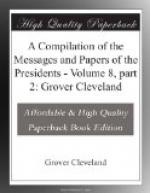First. That the limits of Nova Scotia had been altered from the southern bank of the St. Lawrence to the highlands described in the treaty of peace.
Second. That if the river Schoodiac were the true St. Croix the northwest angle of Nova Scotia could be formed by the western and northern boundaries (the meridian line and the highlands).
Third. That the territory of Acadie, or Nova Scotia, was, the same territory granted to Sir William Alexander.
Fourth. That the sea and Atlantic Ocean were used as convertible terms.
Fifth. That from the date of the treaty of Utrecht the boundary between Massachusetts and Nova Scotia was that of the patent to Sir William Alexander.
Sixth. That the Provinces of Quebec and Nova Scotia belonged to and were in possession of His Britannic Majesty in 1783, and that he had an undoubted right to cede to the United States such part of them as he might think fit.
Seventh. That the due north line from the source of the St. Croix must of necessity cross the St. John.
It has since been maintained on the part of Great Britain:
First. That the limits of Nova Scotia never did extend to the St. Lawrence.
Second. That the northwest angle of Nova Scotia was unknown in 1783.
Third. That Acadie extended south to the forty-sixth degree of north latitude, and was not the same with Nova Scotia.
Fourth. That the sea and the Atlantic Ocean were different things.
Fifth. That the claims and rights of Massachusetts did not extend to the western bounds of the grant to Sir William Alexander.
Sixth. That this being the case the cession of territory not included within her limits is void.
Seventh. That it could never have been intended that the meridian line should cross the St. John.
Note XIII.
It has been pretended that the grant of the fief of Madawaska in 1683 can be urged as a bar to the claim of Massachusetts. That fief, indeed, was among the early grants of the French governors of Canada, but it is not included in the claim which the French themselves set up. It was therefore covered by the Massachusetts charter, because the grant had never been acted upon. Even up to the present day this fief can hardly be said to be settled or occupied except by the retainers of the garrison of Fort Ingall, and from all the evidence which could be found on the spot it appeared that no settlement had ever been made upon it until the establishment of a posthouse some time between the date of the treaties of 1783 and 1794. It therefore was not at the time the charter of Massachusetts was granted (1691) “actually possessed or inhabited by any other Christian prince or state.”




